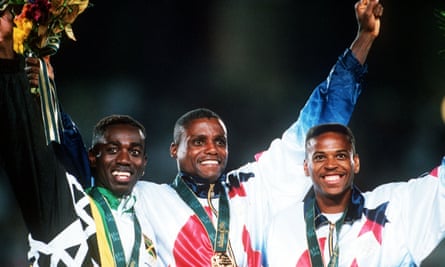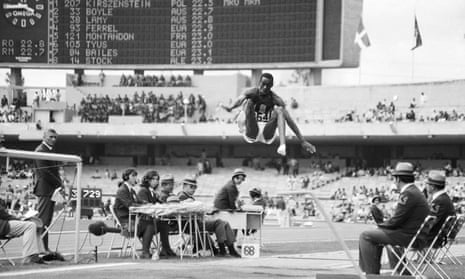Even at 55 years’ distance, Bob Beamon’s gravity-defying leap at the 1968 Olympics takes the breath away. I watched it again after World Athletics floated plans to scrap the long jump board in favour of a large “take-off zone” to eliminate fouls, and it remains six seconds of sporting perfection. Those 19 rhythmic strides down the runway, the board hit with millimetric precision. Then Beamon’s long legs launching and fluttering high through the Mexico air, like a man pedalling furiously on an imaginary recumbent bicycle, before landing 8.90 metres away.
The American didn’t just break the world record that day. He shattered it by 55 centimetres. As Sports Illustrated put it: “Beamon, in effect, had taken off into thin air in the year 1968 and landed somewhere in the next century.” But now long jump risks being changed forever – for the worse.
Last summer the World Athletics president, Sebastian Coe, warned that his sport faced “a race against time” to stay relevant, and announced a deep data review to assess which events were still popular. That is yet to be published, but I understand that various metrics from the world championships in Budapest show that audience attention – in the stadium and on TV – dipped noticeably for the long jump, 3,000m steeplechase and several other field events.
The fact that a third of long jumps were fouls in Budapest did not help. Hence the idea of trialling a take-off zone, which would measure from where the athlete takes off to where they land in the pit. “That means every single jump counts, it adds to the jeopardy of the competition, the drama of the competition,” World Athletics’ CEO, Jon Ridgeon, explained last week.
I like Ridgeon. And clearly something needs to be done. However if you really believe a take-off zone will be a gamechanger I have some Chris Tomlinson non-fungible tokens to sell you. The four-time Olympic champion Carl Lewis called the proposal an “April Fools’ joke”, which summed up the seething anger within track and field, and the women’s world champion Ivana Spanovic urged World Athletics to find a balance between promoting the sport and preserving its basic values.

So let’s float an idea that does exactly that. Make the long jump a knockout competition. Jumper versus jumper going head to head, with only one advancing to the next round, until the last two square off for the gold medal.
Here is how I would do it. Run a qualifying event as normal, with everyone having three jumps to record their longest distance. The top eight would then make it to the next day’s knockout tournament, with the top qualifier facing the eighth-best in the quarter-finals, and so on. In each match, the athlete would take two jumps in a shootout-style format – with the longest progressing.
Why would this work? First, each head-to-head would last only five minutes or so. And it would be shown when no other action was on in the stadium. That alone would be a gamechanger. Field events struggle because TV constantly cuts away from the action, making it hard to sustain any narrative. But at a stroke this problem would be eliminated.
Second, almost every jump would matter. You want jeopardy? This gives you it in spades. You mess up your first jump in your Olympic quarter-final and suddenly you have one shot at redemption, otherwise four years of training goes up in smoke.
Third, the long jump itself would not fundamentally change. It would still be about speed, athleticism and precision, the winner would still take no more than six jumps, but the event could now be completed in an hour or so. In fact, I would roll this format to most field events. They would all become more exciting and watchable.
after newsletter promotion
Meanwhile if World Athletics wants free advice about how to attract bigger audiences, it really should listen to the excellent The Rest Is Entertainment podcast by my colleague Marina Hyde and Richard Osman when they discussed why the world championship darts tournament was so successful.
Clearly, as both pointed out, the performance of a 16-year-old Luke Littler was the biggest factor. But other factors were at play as Osman, who has been responsible for numerous successful game shows, pointed out. “The format of darts is the best there is,” he said, noting that viewers were never more than a minute or two from seeing a high-stakes throw. “Because it’s all jeopardy.”
“Sport has always been and always will be soap opera,” he added. “It is who is a goodie, who is a baddie. But you can’t do a soap opera unless you know the characters.” Every athlete should have those three sentences drummed into them in media training. These days they are not only battling their rivals for attention, but other sports, along with everything else on Netflix, TikTok and more.
One person who gets it is world 1500m champion Josh Kerr, who will be the star attraction in Glasgow. He has not raced against the Olympic gold medallist Jakob Ingebrigtsen since beating him last summer, but the pair have kept their highly entertaining rivalry burning all winter by taking various potshots at each other. And when they do race again, you can bet your bottom dollar that more will watch.
Ultimately, track and field really doesn’t need take-off zones if it wants to achieve liftoff. It just needs to make more people care. Establishing a better narrative arc, more rivalries and controversy, and providing more jeopardy, is the way to do it.
